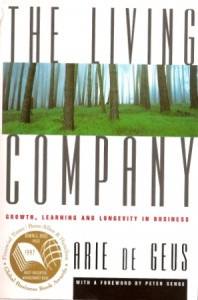The one-sentence summary
Companies are living entities that thrive by learning, having a strong persona, and governing their growth efficiently.
- What if we thought about a company as a living being, rather than just a series of monetary assets?
- Seeing a company as a machine implies that it is fixed, that it will eventually run down, and that its people are straightforward (human) resources.
- Living companies evolve naturally because people generate change, they regenerate naturally, and can learn as entities.
- Living companies have four components:
- Learning: sensitivity to the environment and an ability to learn and adapt
- Persona: cohesion and identity as aspects of an innate ability to build a community
- Ecology: tolerance, decentralisation, and an ability to build relationships with other entities
- Evolution: ability to govern its own growth effectively, including conservative finance
- The average company lifespan is 40 years, with humans lasting 70. They die early because the thinking and language of management are too narrowly based on economics. They forget that their organisation’s true nature is that of a community of humans.
WHAT’S GOOD ABOUT IT
- Possible reasons why managers fail include:
-
Managers are stupid (he does not believe this)
-
We can only see when a crisis opens our eyes
-
We can only see what we have already experienced
-
We cannot see what is emotionally difficult to see
-
We can only see what is relevant to our view of the future
-
- This is all based on what the Swedish neurobiologist David Ingvar calls a ‘memory of the future’, in which we have envisaged a series of scenarios. Usually 60% are positive and 40% negative, but if the balance is disturbed then incorrigible optimists or pessimists take centre stage.
- In the 1930s, the corporate world tried to address this with ‘tools for foresight’ – the dreaded strategic planning that creates the illusion of certainty where there is none.
- Most companies learn through Perceiving, Embedding, Concluding and Acting.
WHAT YOU HAVE TO WATCH
- The author spent his entire career at Shell so all the examples come from there.

